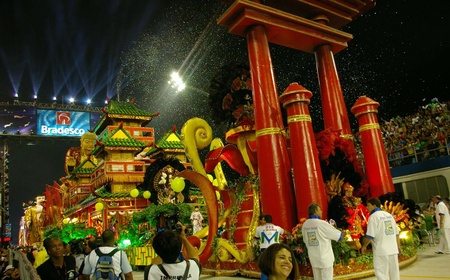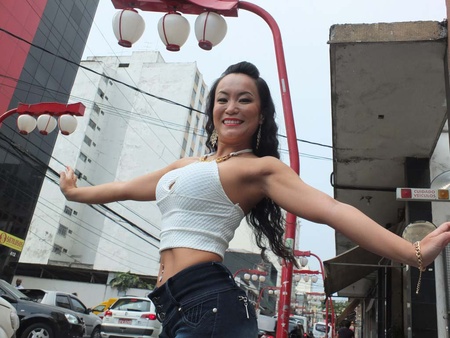Read Part 1 >>
The first time Japanese immigration is the topic
Japanese immigrants, who had kept their distance from Carnival, were first chosen as the theme of the parade in 1983 by the Escola "Barroca Zona Sul" in the city of São Paulo. At the time, they were the top-ranking special group, and paraded to the theme song "75 Years of Immigration or the Land of the Rising Sun," placing sixth out of ten teams. At that time, they closed off Tiradentes Avenue only during Carnival, and used it as a samba venue (Sambadromo).
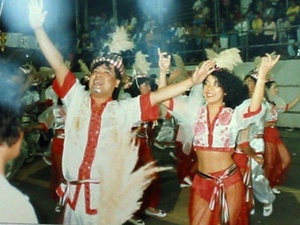
The man who played a central role in this was Kikko (Kiyoyuki Akamine, 45 years old at the time of the interview in 2003, from Okinawa Prefecture). He was a child immigrant who emigrated to Okinawa with his family at the age of seven after the war.
Kikko was invited by Kimura William, the Portuguese editor of the Nippaku Mainichi Shimbun at the time, to "Let's do a carnival for Japanese immigrants together," and together with Ogawa Felicia and Kusunoki Takao, they ran around and organized an ala (troupe) of 300 Japanese people. This was the beginning of the full-scale "Japanese immigrant samba."
Due to financial problems, Kikko went to Japan as a dekasegi worker in 1989, and when the samba parade began in 1991 in Oizumi Town, Gunma Prefecture, now famous as "Brazil Town," Kikko livened up the event by performing the authentic samba no pé (a unique samba step), and in 1994 he even served as a singer for the samba team.
In fact, in 1983, a float themed on Japanese immigration, "Kagura on the Kasato Maru (the first immigrant ship)," was also performed. "Flor da Peña," in the fourth category, four places below the Special Group, did not have a Japanese immigration theme, but was brought to life by the late Hosokawa Akio, who was then chairman of the Brazilian Hiroshima Kagura Preservation Society, with a plan to combine kagura with samba. However, it finished in ninth place, one place below last place.
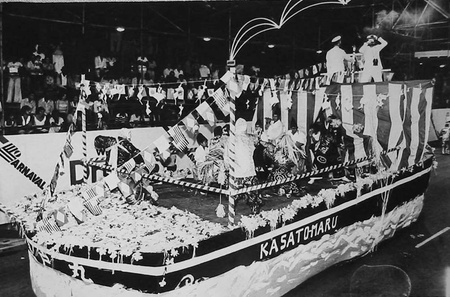
Part of Brazilian culture
The next was in 1998, the 90th anniversary of Japanese immigration, when the special group Escola "Bye-Bye" won the championship with their song "Banzai! Bye-Bye", which advocated for the integration of Japanese and Brazilian culture. Since then, the Escola has achieved the feat of winning four years in a row. That is how big the impact of the parade's oriental design was.
A scene from the Immigration Centenary Parade, where Bye Bye won the championship.
In 2008, the 100th anniversary of Japanese immigration, the special group "Unidos da Vila Maria" from Sao Paulo put on a magnificent parade, coming in third place. The diverse symbols cultivated over the last 100 years were woven throughout the parade, making it a truly spectacular sight.
In the Rio competition, the group Porto da Pedra fought well, but unfortunately finished in 11th place. Nevertheless, the fact that the 100th anniversary of Japanese immigration was celebrated simultaneously in the two cities of São Paulo and Rio at the world-famous Brazilian Carnival was groundbreaking in itself.
In 2008, some escolas in the central Amazon basin, including Manaus, Mato Grosso, and Santa Catarina, chose the 100th anniversary as their theme for their carnival. Most notably, the city of Mogi das Cruzes, near São Paulo, known for its large Japanese population, chose the 100th anniversary as the common theme for the entire carnival, and all 10 participating teams sang about Japanese immigration and held parades.
If Rio shows the breadth of influence, Moji's example shows the depth of penetration of Japanese immigrants.
At midnight on February 16, 2015, a special group from Sao Paulo called "Aguia de Ouro" will be holding a parade with the theme of the 120th anniversary of the establishment of diplomatic relations between Japan and Brazil. This is a team with the ability to have placed third for the past two consecutive years, and if they can perform well, they are expected to have a good shot at winning.
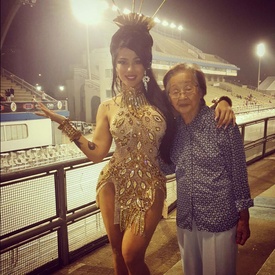
The role of Enbaishatrice (Diplomatic Friendship Princess), which can be said to be the successor to Raina (Queen), the highest rank for female dancers in Agia, is played by Natalia Yukari Inoue (28). She is a third-generation Japanese who was raised by her grandmother from Saga Prefecture in place of her busy parents, speaks Japanese, and loves Japanese food.
He gained popularity after appearing on Recorde TV's reality show "Fazenda de Verão (Summer Farm)" in 2012, and is now an up-and-coming Japanese celebrity, having appeared on the cover of the Brazilian edition of Playboy in September last year.
Japanese immigrants who became part of Brazilian folklore
The Carnival parade can be described as a "march opera," in which a drama that has been meticulously crafted over the course of a year is expressed in a roughly hour-long parade involving 4,000 citizens.
Each float and costume is dotted with symbols related to the theme of the year, and the lyrics and the whole performance are meant to tell a single story. They are judged based on around nine criteria.
In Carnival, a unique Brazilian culture supported by the common people, Japanese immigration is already a standard theme. The same can be said for Italian immigration, etc. "Bila Maria," which came in third for the 100th anniversary of Japanese immigration, took on the theme of the 50th anniversary of Korean immigration in 2013, and took every precaution by employing Sicco Spinosa, the carnavalesco (general director) who had been the winning group for "Bye Bye," but ended up coming in last and being demoted to the second division. It is difficult to read the judges' evaluations of immigration material.
If we look into the historical context of samba, the fact that Japanese immigrants have been treated as a theme and have received high praise means that they have been recognized by the most conservative circles as part of the country's "folklore" or "modern history."
The parades in Rio and Sao Paulo were broadcast by satellite by Globo TV and reached the eyes of millions of people around the world. It can be said that Japanese immigrants have become a part of Brazilian folklore from a global perspective.
Recently, the Brazilian media has started to describe the Asakusa Samba Carnival as the "second largest samba carnival in the world." The theme song for this festival includes the word "Asakusa," and Miku Oguchi (33, Kanagawa) was specially invited to play the role of Madrinha da Bateria.
In the larger context of globalization, the phenomenon of the cultures of the two countries, located on opposite sides of the globe, mixing together due to immigration may be accelerating.
© 2015 Masayuki Fukasawa


